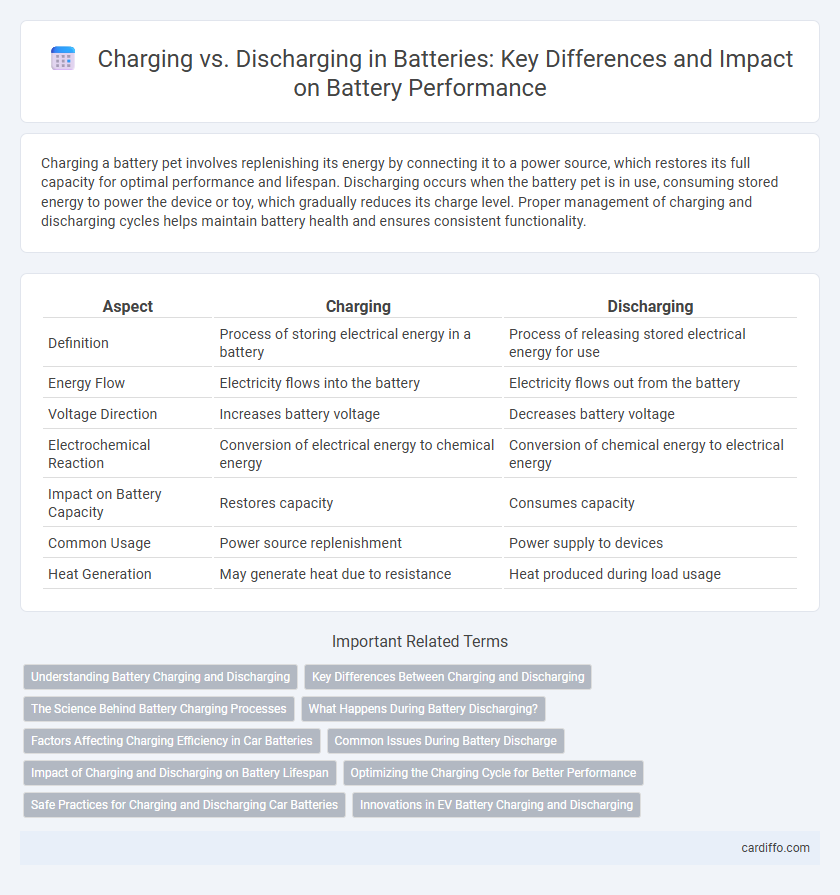Charging a battery pet involves replenishing its energy by connecting it to a power source, which restores its full capacity for optimal performance and lifespan. Discharging occurs when the battery pet is in use, consuming stored energy to power the device or toy, which gradually reduces its charge level. Proper management of charging and discharging cycles helps maintain battery health and ensures consistent functionality.
Table of Comparison
| Aspect | Charging | Discharging |
|---|---|---|
| Definition | Process of storing electrical energy in a battery | Process of releasing stored electrical energy for use |
| Energy Flow | Electricity flows into the battery | Electricity flows out from the battery |
| Voltage Direction | Increases battery voltage | Decreases battery voltage |
| Electrochemical Reaction | Conversion of electrical energy to chemical energy | Conversion of chemical energy to electrical energy |
| Impact on Battery Capacity | Restores capacity | Consumes capacity |
| Common Usage | Power source replenishment | Power supply to devices |
| Heat Generation | May generate heat due to resistance | Heat produced during load usage |
Understanding Battery Charging and Discharging
Battery charging involves the conversion of electrical energy into chemical energy stored within the battery cells, while discharging reverses this process by transforming chemical energy back into electrical power to run devices. Understanding the state of charge (SoC) and depth of discharge (DoD) is critical for optimizing battery life and performance, as overcharging or deep discharging can degrade battery capacity. Efficient management of charging and discharging cycles enhances energy storage reliability and extends the overall lifespan of lithium-ion and other rechargeable batteries.
Key Differences Between Charging and Discharging
Charging involves the process of restoring a battery's energy by converting electrical energy into chemical energy, increasing its voltage and state of charge. Discharging occurs when the stored chemical energy is converted back into electrical energy to power devices, causing a decrease in voltage and state of charge. Key differences include the direction of electron flow, energy conversion processes, and the battery's operational state during each phase.
The Science Behind Battery Charging Processes
Battery charging involves the electrochemical process of reversing the discharge reactions to restore chemical energy. During charging, an external electrical source drives ions from the cathode to the anode through the electrolyte, reconfiguring the electrode materials at the molecular level. The efficiency and speed of charging depend on factors such as ion mobility, electrode surface area, electrolyte composition, and temperature.
What Happens During Battery Discharging?
During battery discharging, chemical reactions inside the battery convert stored chemical energy into electrical energy, supplying power to connected devices. Electrons flow from the anode to the cathode through the external circuit, while ions move through the electrolyte internally to maintain charge balance. This process gradually depletes the active materials, reducing the battery's voltage and capacity until a recharge is needed.
Factors Affecting Charging Efficiency in Car Batteries
Charging efficiency in car batteries is influenced by temperature, state of charge, and charging rate, with optimal conditions typically between 20-25degC ensuring minimal energy loss. High temperatures can accelerate chemical reactions, reducing battery life, while low temperatures increase internal resistance and slow the charging process. Proper charging protocols and battery management systems optimize energy transfer, preventing overcharging or undercharging that degrades battery performance.
Common Issues During Battery Discharge
Common issues during battery discharge include voltage drop, capacity loss, and increased internal resistance, which reduce overall battery performance and runtime. Overdischarging can lead to irreversible damage, causing battery cells to deteriorate and shorten the lifespan of the battery. Monitoring discharge rates and maintaining optimal temperature conditions are crucial to prevent premature battery failure and ensure efficient energy utilization.
Impact of Charging and Discharging on Battery Lifespan
Charging and discharging cycles significantly impact battery lifespan by causing gradual capacity loss and increased internal resistance over time. High charging currents and deep discharges accelerate electrode degradation, reducing the total number of effective cycles. Optimal battery maintenance involves moderate charging rates and avoiding extreme discharge levels to maximize overall longevity and performance.
Optimizing the Charging Cycle for Better Performance
Optimizing the charging cycle involves controlling the voltage and current to prevent overcharging and overheating, which extends battery lifespan and maintains capacity. Implementing smart charging protocols, such as constant current/constant voltage (CC/CV) methods, improves efficiency and reduces energy loss during charging. Monitoring temperature and state of charge (SoC) in real-time helps balance charging speed with battery health, ensuring consistent performance and reliability.
Safe Practices for Charging and Discharging Car Batteries
To ensure safe practices for charging and discharging car batteries, always use a charger compatible with the battery's voltage and avoid overcharging by monitoring the charging process carefully. Discharging should be controlled to prevent deep discharge, which can damage the battery's cells and reduce its lifespan. Regularly inspect battery terminals for corrosion and maintain proper ventilation during both charging and discharging to avoid the buildup of hazardous gases.
Innovations in EV Battery Charging and Discharging
Innovations in EV battery charging include ultra-fast charging technologies that reduce charging time to under 20 minutes, supported by advancements in solid-state batteries with higher energy densities and improved thermal management systems. On the discharging front, bidirectional charging enables vehicle-to-grid (V2G) and vehicle-to-home (V2H) functionalities, optimizing energy use by allowing EVs to supply power back to the grid during peak demand. Enhanced battery management systems (BMS) continuously monitor cell health and optimize charge/discharge cycles to extend battery lifespan and improve overall efficiency.
Charging vs Discharging Infographic

 cardiffo.com
cardiffo.com